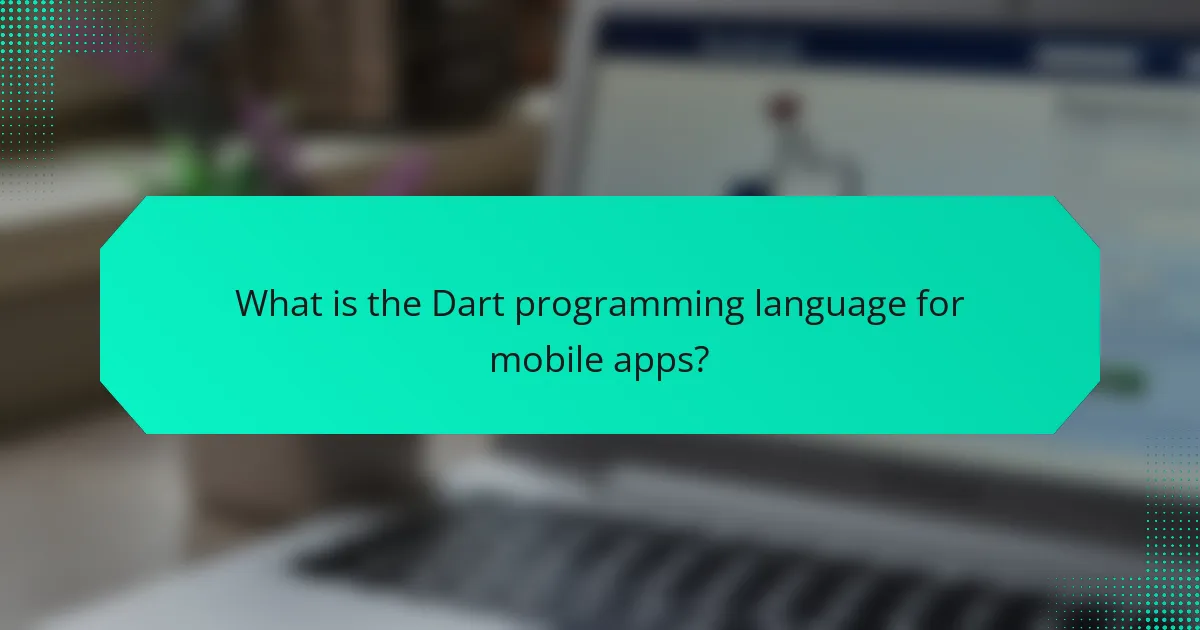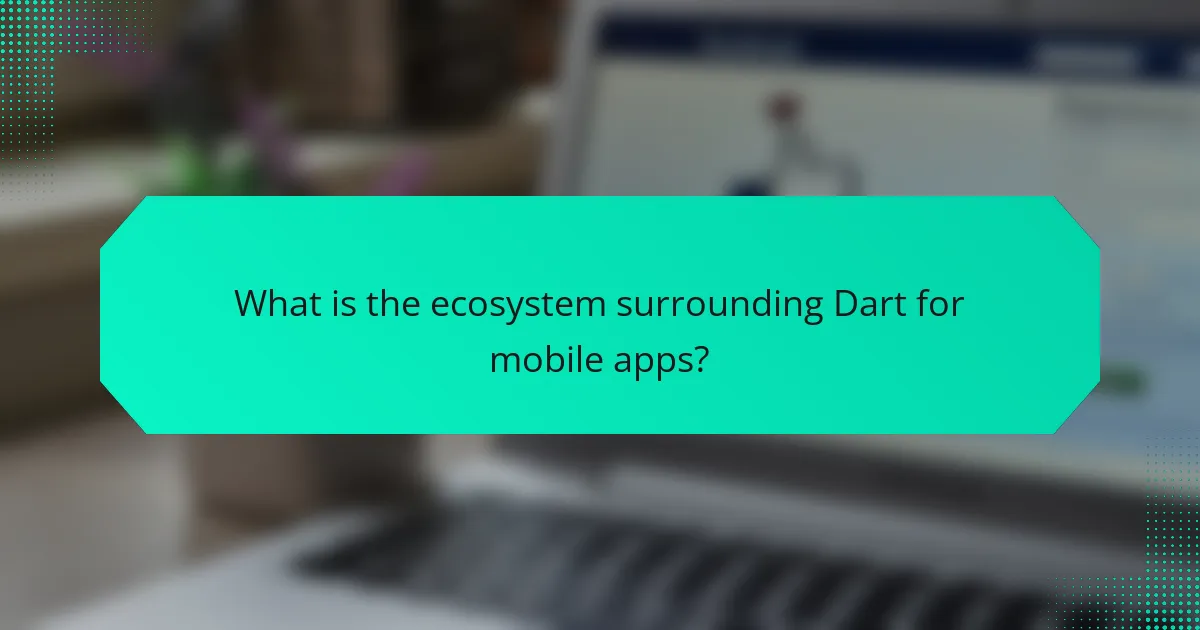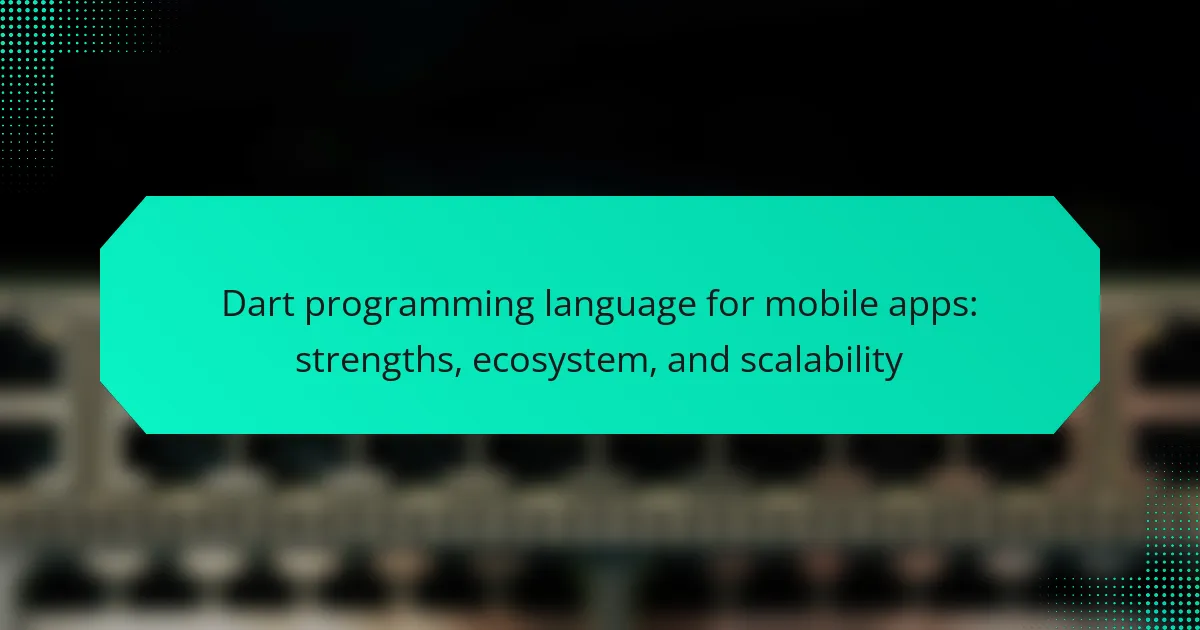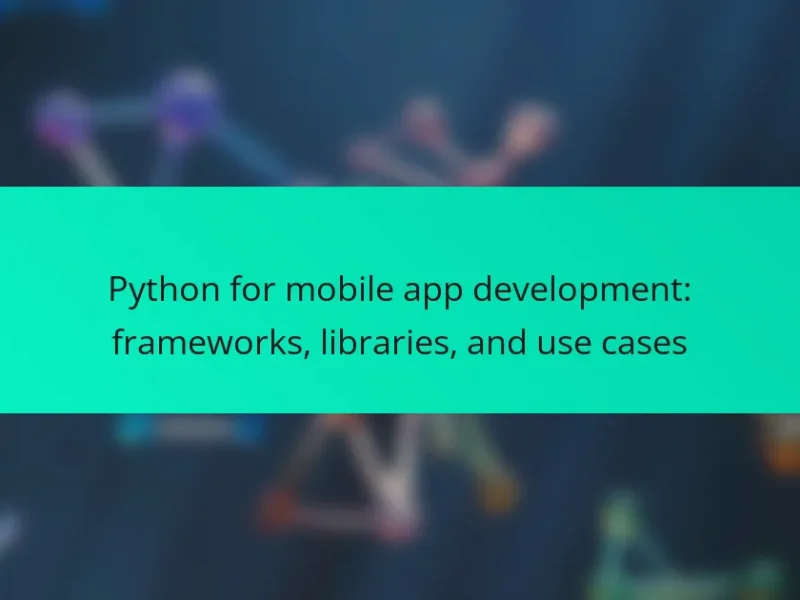Dart is a programming language developed by Google, specifically optimized for building high-performance mobile applications on both Android and iOS platforms. It features a strong type system, modern syntax, and supports asynchronous programming, enhancing the responsiveness of mobile apps. The Dart ecosystem includes the Flutter framework, which facilitates cross-platform development through a rich set of pre-designed widgets and a reactive programming model. Additionally, Dart’s modular architecture promotes scalability and code reusability, making it suitable for both small and large projects. The combination of Dart and Flutter, along with robust community support and various tools, streamlines the app development process.

What is the Dart programming language for mobile apps?
Dart is a programming language optimized for building mobile apps. It is developed by Google and supports both Android and iOS platforms. Dart is designed for high performance and productivity. It features a strong type system and modern syntax. Dart is often used with the Flutter framework for creating natively compiled applications. This combination allows for fast development and expressive UI. The language supports asynchronous programming, which enhances responsiveness in mobile applications. Dart’s ecosystem includes a rich set of libraries and tools, facilitating efficient app development.
How does Dart differ from other programming languages?
Dart differs from other programming languages primarily through its strong support for asynchronous programming. This is facilitated by features like Futures and Streams, which enable non-blocking operations. Dart’s just-in-time (JIT) compilation allows for fast development cycles, while ahead-of-time (AOT) compilation enhances performance for production applications. Additionally, Dart is designed to work seamlessly with the Flutter framework, which is specifically tailored for mobile app development. This integration provides a rich set of pre-designed widgets and tools that streamline the UI creation process. Dart’s syntax is also easy to learn, especially for those familiar with Java or JavaScript. Overall, these characteristics make Dart particularly suited for building high-performance mobile applications.
What are the unique features of Dart that benefit mobile app development?
Dart has several unique features that significantly benefit mobile app development. Its Just-In-Time (JIT) compilation allows for fast development cycles. This feature enables developers to see changes in real-time, enhancing productivity. Additionally, Dart’s Ahead-Of-Time (AOT) compilation optimizes performance for production apps. AOT compilation results in smaller app sizes and faster startup times.
Dart supports a rich set of libraries and frameworks, such as Flutter, which simplifies UI development. Flutter provides a single codebase for both iOS and Android, reducing development time and effort. The language’s strong typing system helps catch errors during development, improving code quality.
Furthermore, Dart’s asynchronous programming capabilities allow for smooth user experiences. Developers can handle multiple tasks without blocking the user interface. This feature is crucial for mobile apps that require responsiveness.
Overall, Dart’s combination of JIT and AOT compilation, extensive libraries, strong typing, and asynchronous support makes it a powerful choice for mobile app development.
How does Dart’s syntax contribute to its usability?
Dart’s syntax enhances usability through its clear and concise structure. It uses a C-style syntax that is familiar to many developers. This familiarity reduces the learning curve for those transitioning from other languages. Dart also supports optional typing, allowing developers to write less verbose code. This flexibility accommodates both dynamic and static typing preferences. Furthermore, its features like async-await simplify asynchronous programming. This leads to more readable and maintainable code. Dart’s syntax also includes powerful features like extension methods, improving code reusability. Overall, these elements contribute to a more efficient development experience.
What are the key strengths of Dart for mobile app development?
Dart’s key strengths for mobile app development include its performance, hot reload feature, and strong community support. Dart compiles to native code, ensuring high performance on both Android and iOS devices. The hot reload feature allows developers to see changes instantly without losing the current app state. This accelerates the development process significantly. Dart’s strong typing and modern language features enhance code quality and maintainability. Additionally, the Flutter framework, which uses Dart, provides a rich set of pre-designed widgets. This simplifies UI development and improves the user experience. The growing community around Dart contributes to a wealth of resources and libraries, further enhancing its capabilities.
How does Dart enhance developer productivity?
Dart enhances developer productivity through its strong support for asynchronous programming. This feature allows developers to write non-blocking code, improving application performance. The language’s hot reload capability lets developers see changes in real-time, speeding up the development cycle. Dart’s rich standard library provides pre-built functionalities, reducing the need to write boilerplate code. Its object-oriented structure promotes code reuse and maintainability. Dart’s integration with Flutter enables a single codebase for multiple platforms, further streamlining the development process. Additionally, Dart’s comprehensive tooling, including IDE support, aids in efficient debugging and testing. These factors collectively contribute to a more productive development environment.
What performance advantages does Dart offer for mobile applications?
Dart offers several performance advantages for mobile applications. It compiles to native code, enabling fast startup times and efficient execution. Dart’s Just-In-Time (JIT) compilation allows for hot reload, which speeds up the development process by enabling real-time code updates. The language supports asynchronous programming, enhancing responsiveness in mobile apps. Dart’s garbage collection is optimized for low-latency, which minimizes performance hiccups during runtime. Additionally, the Flutter framework, built with Dart, leverages a rich set of pre-built widgets, reducing the need for complex UI code and improving rendering performance. These features collectively enhance the overall user experience in mobile applications.
Why is Dart gaining popularity in the mobile app ecosystem?
Dart is gaining popularity in the mobile app ecosystem due to its performance and ease of use. The language offers a single codebase for both iOS and Android applications. This reduces development time and costs significantly. Dart’s integration with the Flutter framework enhances its appeal. Flutter allows for fast UI rendering and hot reload features. These features improve the development workflow and user experience. According to a 2023 Stack Overflow survey, Dart ranked among the top programming languages for mobile development. This indicates a growing community and support for Dart.
What factors contribute to Dart’s growing community and support?
Dart’s growing community and support stem from its strong performance and ease of use. The language offers a modern syntax that is approachable for developers. Its integration with Flutter enhances its appeal for mobile app development. Dart’s performance is optimized for both client-side and server-side applications. The backing of Google provides credibility and resources for development. Active community engagement through forums and meetups fosters collaboration. Comprehensive documentation and learning resources support new developers. Regular updates and feature enhancements keep the language relevant and competitive.
How do industry trends influence Dart’s adoption?
Industry trends significantly influence Dart’s adoption by shaping developer preferences and technology choices. The rise of cross-platform development frameworks has increased demand for Dart. For instance, Flutter, which uses Dart, has gained popularity for building mobile applications efficiently. In 2021, Flutter became the most popular cross-platform framework according to the Stack Overflow Developer Survey. Additionally, industry shifts toward mobile-first strategies encourage businesses to adopt Dart for its performance and scalability. The growing emphasis on developer productivity also drives interest in Dart, as it offers features like hot reload and a strong type system. These trends collectively enhance Dart’s relevance in the programming landscape.

What is the ecosystem surrounding Dart for mobile apps?
The ecosystem surrounding Dart for mobile apps includes a variety of tools, libraries, and frameworks. Flutter is the primary framework built on Dart for creating cross-platform mobile applications. It offers a rich set of pre-designed widgets and a reactive programming model. Dart also integrates with popular IDEs like Visual Studio Code and Android Studio, enhancing developer productivity. The Dart package manager, Pub, provides access to numerous packages for added functionality. Community support is robust, with extensive documentation and forums available for developers. This ecosystem facilitates rapid development and deployment of mobile applications.
What tools and frameworks support Dart development?
Dart development is supported by several tools and frameworks. The primary framework is Flutter, which allows for building natively compiled applications for mobile, web, and desktop from a single codebase. DartPad is an online editor for experimenting with Dart code directly in the browser. The Dart SDK provides essential libraries and tools for developing, testing, and compiling Dart applications. Additionally, Visual Studio Code and Android Studio offer plugins for enhanced Dart development. These tools collectively enhance productivity and streamline the development process.
How does Flutter enhance Dart’s capabilities for mobile apps?
Flutter enhances Dart’s capabilities for mobile apps by providing a rich framework that simplifies UI development. It allows for rapid development through a hot reload feature, enabling developers to see changes in real-time. Flutter’s widget-based architecture promotes reusable components, which streamlines the design process. Additionally, Flutter integrates seamlessly with Dart’s asynchronous programming features, improving performance in mobile applications. The framework includes a comprehensive set of pre-designed widgets, which accelerates the development of visually appealing interfaces. Flutter also supports cross-platform development, allowing a single codebase to run on both iOS and Android. This capability significantly reduces development time and costs while maintaining high performance. Overall, Flutter leverages Dart’s strengths, making mobile app development more efficient and effective.
What IDEs are best suited for Dart programming?
Visual Studio Code and IntelliJ IDEA are the best IDEs for Dart programming. Visual Studio Code offers excellent support for Dart through extensions. It provides features like code completion, debugging, and integrated terminal. IntelliJ IDEA, particularly the Ultimate version, has robust Dart support built-in. It includes powerful refactoring tools and a rich plugin ecosystem. Both IDEs are widely used in the Dart community. They enhance productivity and streamline the development process.
What resources are available for learning Dart?
Official Dart documentation is a primary resource for learning Dart. It provides comprehensive guides and tutorials. The documentation is available on the Dart website. Online platforms like Udemy and Coursera offer Dart courses. These courses often include video lectures and hands-on projects. Books such as “Programming Dart” offer in-depth knowledge. Community forums like Stack Overflow provide support and answers. Additionally, GitHub hosts various Dart projects for practical learning. These resources cater to different learning styles and levels.
Which online courses and tutorials are recommended for beginners?
Recommended online courses for beginners in Dart programming include “The Complete Dart Language Course” on Udemy and “Dart Programming for Beginners” on Coursera. These courses cover foundational concepts and practical applications. They provide hands-on projects to reinforce learning. Tutorials on YouTube, such as “Dart Programming Tutorial for Beginners” by Academind, are also beneficial. These resources are structured to facilitate understanding of Dart’s syntax and features. They cater specifically to those new to programming.
What documentation and community forums exist for Dart developers?
Dart developers can access official documentation and community forums for support. The official Dart documentation is available at dart.dev. It provides comprehensive guides, tutorials, and API references. Additionally, developers can engage with the Dart community on platforms like Stack Overflow and Reddit. The Dart subreddit and Stack Overflow tag for Dart are popular for discussions and problem-solving. These resources are vital for learning and troubleshooting within the Dart ecosystem.

How scalable is Dart for mobile applications?
Dart is highly scalable for mobile applications. It supports both small and large projects effectively. Dart’s architecture allows for modular development. This modularity facilitates code reuse and maintenance. The Flutter framework, built on Dart, enhances scalability by offering a rich set of widgets. These widgets can be customized and extended. Dart’s asynchronous programming model also supports high-performance applications. This model allows for efficient handling of multiple tasks simultaneously. Overall, Dart’s design and ecosystem make it suitable for scalable mobile app development.
What scalability features does Dart provide?
Dart provides several scalability features that enhance its usability for mobile app development. It supports Just-In-Time (JIT) compilation for rapid development and hot reload capabilities. This allows developers to see changes in real-time, improving productivity. Dart also offers Ahead-Of-Time (AOT) compilation, which optimizes performance for production apps. The language supports asynchronous programming through Futures and Streams, enabling efficient handling of concurrent tasks. Dart’s strong typing system helps catch errors early, improving maintainability. Additionally, the Flutter framework, built on Dart, facilitates the creation of scalable UIs through widget composition. These features collectively contribute to Dart’s capability to handle large-scale applications effectively.
How does Dart handle large-scale applications?
Dart handles large-scale applications through features like strong typing, asynchronous programming, and modular architecture. Strong typing helps catch errors during development, improving code quality. Asynchronous programming allows efficient handling of operations without blocking the main thread. Modular architecture enables developers to break applications into smaller, manageable components. This structure enhances maintainability and scalability. Dart also supports the use of packages and libraries, facilitating code reuse. The Flutter framework, built on Dart, provides tools for building complex UIs efficiently. These features collectively support the development of robust large-scale applications.
What are the performance implications of scaling with Dart?
Scaling with Dart can lead to performance improvements, but it requires careful consideration of architecture and resource management. Dart’s asynchronous programming model allows for efficient handling of multiple tasks, which can enhance responsiveness in applications. The Dart VM optimizes performance through Just-In-Time (JIT) compilation for development and Ahead-Of-Time (AOT) compilation for production, resulting in faster execution times. Furthermore, Dart’s garbage collection mechanism is designed to minimize latency, which is beneficial when scaling applications.
In practice, developers have reported that scaling Dart applications often results in a smoother user experience compared to other languages. This is due to Dart’s ability to manage memory effectively and its support for reactive programming paradigms. Additionally, the Flutter framework, which uses Dart, provides tools that help optimize rendering performance during scaling. Overall, while scaling with Dart can yield significant performance benefits, it necessitates an understanding of its unique features and best practices for optimal results.
What best practices should developers follow for scalability in Dart?
Developers should follow several best practices for scalability in Dart. First, they should utilize asynchronous programming to improve performance. Dart’s Future and Stream classes facilitate non-blocking operations. This allows applications to handle multiple tasks simultaneously.
Second, developers must structure their code using modular design principles. This enhances maintainability and allows for easier scaling. By breaking down the application into smaller, reusable components, developers can manage complexity effectively.
Third, efficient state management is crucial. Utilizing libraries like Provider or Riverpod helps in managing state across the app. This ensures that the app can scale without performance degradation.
Fourth, developers should optimize widget rebuilds. By using const constructors and the Flutter framework’s built-in capabilities, unnecessary rebuilds can be minimized. This leads to improved rendering performance.
Fifth, leveraging Dart’s built-in tools for profiling and debugging is essential. Tools like Dart DevTools help identify performance bottlenecks. This allows developers to make informed decisions about scalability.
Lastly, adopting a continuous integration and deployment (CI/CD) pipeline is beneficial. This practice ensures that new features can be integrated and deployed smoothly. It contributes to maintaining scalability as the application grows.
How can developers optimize Dart code for better performance?
Developers can optimize Dart code for better performance by using effective coding practices. They should prefer final variables over var when possible. This approach allows the Dart compiler to make optimizations. Additionally, using asynchronous programming can improve responsiveness. It prevents blocking the main thread during heavy computations.
Minimizing the use of unnecessary object allocations can also enhance performance. This reduces garbage collection overhead. Developers should utilize const constructors for immutable widgets. This practice can lead to better memory usage.
Profiling tools like Dart DevTools can help identify performance bottlenecks. By analyzing the performance metrics, developers can make informed decisions. They should also leverage the Flutter framework’s built-in performance features. These features include widget rebuilding optimizations and effective state management.
What common pitfalls should be avoided when scaling Dart applications?
Common pitfalls to avoid when scaling Dart applications include neglecting performance optimization. Dart applications can suffer from slow performance if not properly optimized. Another pitfall is failing to manage state effectively. Poor state management can lead to complex bugs and maintenance challenges. Additionally, ignoring asynchronous programming can cause bottlenecks. Dart’s asynchronous features are essential for responsive applications.
Not utilizing Dart’s built-in libraries can also hinder scalability. These libraries provide efficient solutions for common problems. Furthermore, inadequate testing can result in undetected issues. Comprehensive testing ensures that the application can handle increased loads. Lastly, overlooking community resources can limit knowledge and support. Engaging with the Dart community can provide valuable insights and best practices.
What practical tips can enhance Dart’s effectiveness in mobile app development?
Utilizing Dart’s strong typing can enhance code quality in mobile app development. Strong typing helps catch errors at compile time, reducing runtime issues. Leveraging Flutter with Dart allows for faster UI development. Flutter’s hot reload feature accelerates the development process by enabling real-time updates. Adopting Dart’s asynchronous programming model improves app performance. This model allows for non-blocking operations, enhancing user experience. Using Dart packages from pub.dev can save development time. These packages offer pre-built functionalities, reducing the need to write code from scratch. Following best practices in code organization and structure promotes maintainability. Clean and modular code helps teams collaborate more effectively.
Dart is a programming language developed by Google, specifically optimized for mobile app development on both Android and iOS platforms. This article explores Dart’s strengths, including its performance, asynchronous programming capabilities, and integration with the Flutter framework, which enhances developer productivity and UI creation. Additionally, it examines Dart’s ecosystem, which comprises various tools, libraries, and community support that facilitate efficient app development. The scalability of Dart for large-scale applications is also discussed, highlighting best practices and optimization techniques to ensure robust performance in mobile applications.


